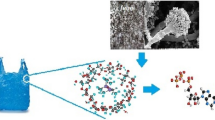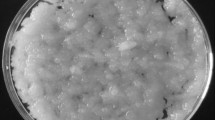Abstract
The accumulation of dry waste containing synthetic polymers due to their resistance to microorganisms and other environmental factors has posed some serious problems to the environment in recent years. On the other hand, plastics constitute the foundations of economy as they are widely used in agriculture, constructions, packaging, health care and also medicine. The aim of this research was to investigate the role of different isolated fungi in the degradation of polycarbonate polymers. For this purpose, sampling was done using the garden soil and waste leachate from Isfahan Waste Management Organization. Samples were enriched in the liquid mineral salt medium supplemented with polycarbonate and then were transferred to the same medium solidified with agar to isolate and identify different fungi. Finally, their biodegradation activity was investigated with the help of clear-zone and atomic force microscopic (AFM) techniques, and also lipase and amylase production was tested. Among 15 isolated genera of mold fungi, Fusarium, Ulocladium, Chrysosporium and Penicillium showed biodegradation activity. According to the diameter of clear zone around the fungal colonies and also AFM results, the highest rate of degradation was related to Fusarium. Lipase activity of all isolated fungi was positive, but amylase activity of Ulocladium was negative. It can be concluded that some fungal strains such as Fusarium can be used for the biodegradation of plastic materials as it leads to a very eco-friendly biodegradation process.



Similar content being viewed by others
References
Azevedo H, Reis R (2005) Understanding the enzymatic degradation of biodegradable polymers and strategies to control their degradation rate. CRC Press, LLC, Boca Raton, FL
Behal A, Singh J, Sharma MK, Puri P, Batana N (2006) Characterization of alkaline α-amylase from Bacillus sp. AB 04. Int J Agric Biol 8(1):80–83
Bentham RH, Morton LGH, Allen NG (1987) Rapid assessment of the microbial deterioration of polyurethanes. Int Biodeterior Biodegrad 23:377–386
Boyandin AN, Rudnev VP, Ivonin VN, Prudnikova SV, Korobikhina KI, Filipenko ML, Volova TG, Sinskey AJ (2012) Biodegradation of polyhydroxyalkanoate films in natural environments. Macromol Symp 320(1):38–42. doi:10.1002/masy.201251004
Chonde Sonal G, Chonde Sachin G, Bhosale PR, Nakade DB, Raut PD (2012) Studies on degradation of synthetic polymer Nylon 6 by fungus Trametes versicolor NCIM 1086. Int J Environ Sci 2(3):2435–2442
Cosgrove L, Mc Geechan L, Robson GS, Handley P (2007) Fungal communities associated with degradation of polyester polyurethane in soil. App Environ Microbiol 73(18):5817–5824
Friedrich J, Zalar P, Mohorcic M, Klun U, Krzan A (2007) Ability of fungi to degrade synthetic polymer nylon-6. Chemosphere 67:2089–2095
Gilan I, Hadar Y, Sivan A (2004) Colonization, biofilm formation and biodegradation of polyethylene by a strain of R. ruber. Appl Microbiol Biotechnol 65:97–104
Gupta VK, Mittal A, Malviya A, Mittal J (2009) Adsorption of carmoisine A from wastewater using waste materials—bottom ash and deoiled soya. J Colloid Interface Sci 335(1):24–33
Gupta VK, Rastogi A, Nayak A (2010) Biosorption of nickel onto treated alga (Oedogonium hatei): application of isotherm and kinetic models. J Colloid Interface Sci 342(2):533–539
Gupta VK, Agarwal Sh, Saleh AT (2011a) Chromium removal by combining the magnetic properties of iron oxide with adsorption properties of carbon nanotubes. Water Res 45(6):2207–2212
Gupta VK, Gupta B, Rastogi A, Agarwal S, Nayak A (2011b) A comparative investigation on adsorption performances of mesoporous activated carbon prepared from waste rubber tire and activated carbon for a hazardous azo dye—ACID Blue 113. J Hazard Mater 186(1):891–901
Jain AK, Gupta VK, Bhatnagar A (2003) A comparative study of adsorbents prepared from industrial wastes for removal of dyes. Sep Sci Technol 38(2):463–481
Kathirsan K (2003) Polythene and plastics-degrading microbes from the mangrove soil. Rev Biol Trop 51(3):629–634
Kim DY, Rhee YH (2003) Biodegradation of microbial and synthetic polyesters by fungi. Appl Microbiol Biotechnol 61:300–308
Kumaravel S, Hema R, Lakshmi R (2010) Production of polyhydroxybutyrate (Bioplastic) and its Biodegradation by Psudumonas Lemoiegenei and Aspergillus Niger. E. J Chem 7:536–542
Lee KM, Gilmore DF, Huss MJ (2005) Fungal degradation of bioplastic PHD (Poly-3-hydroxy-butyric acid). J Polymers Environ 13(3):213–219
Leja K, Lewandowicz G (2009) Polymer biodegradation and biodegradable polymers—a review. Pol J Environ Stud 19:225–266
Maeda H, Yamagata Y, Abe K, Hasegava F, Machida M, Ishioka R, Gomi K, Nakajima T (2005) Purification and characterization of biodegradable plastic-degrading enzyme from Aspergilus orizae. Appl Microbiol Biotechnol 67:78–788
Mittal A, Gupta VK, Malviya A, Mittal J (2008) Process development for the batch and bulk removal and recovery of a hazardous, water-soluble azo dye (Metanil Yellow) by adsorption over waste materials (Bottom Ash and De-Oiled Soya). J Hazard Mater 151(2–3):821–832
Mittal A, Mittal J, Malviya A, Gupta VK (2010) Removal and recovery of Chrysoidine Y from aqueous solutions by waste materials. J Colloid Interface Sci 344(2):497–507
Pranamuda H, Chollakup R, Tokiwa Y (1999) Degradation of polycarbonate by a polyester-degrading strain, Amycolatopsis sp. strain HT-6. Appl Environ Microbiol 65:4220–4222
Premarj R, Mukesh D (2005) Biodegradation of polymers. Indian J Biotechnol 4:168–193
Priyanka N, Archana T (2011) Biodegradability of polythene and plastic by the help of microorganism: a way for brighter future. Environ Anal Toxicol 1(4):1–4
Reddy SV, Thriumala M, Mahmood SK (2008) Biodegradation of polyhydroxy alkanoates. Internet J Microbiol 4(2):95–99. doi:10.5580/1500
Shah AA, Hasan F, Hameed A, Ahmad S (2007) Isolation and characterization of poly (3 hydroxybutyrate-co-3-hydroxyvalerate) degrading bacteria and purification of PHBV depolymerase from newly isolated. Int Biodeterior Biodegrad 60:109–115
Shah AA, Hasan F, Hameed A, Ahmad S (2008) Biological degradation of plastics: a comprehensive review. Biotechnol Adv 26:246–265
Shrivastva N, Tripathi P (2011) Biodegradation of plastic polymer by selected fungal strains: a feasibility study. J Pharm Res 4(9):3056–3059
Suyama T, Tokiwa Y (1997) Enzymatic degradation of aliphatic polycarbonate, poly (tetramethylene carbonate). Enzym Microb Technol 20:122–126
Suyama T, Hosoya H, Tokiwa Y (1998) Bacterial isolates degrading aliphatic polycarbonates. FEMS Microbiol Lett 161:255–261
Tokiwa Y, Suzuki T (1981) Hydrolysis of polyesters containing aromatic and aliphatic ester blocks by lipase. J Appl Polym Sci 26:441–448
Tokiwa Y, Calabia B, Ugwu C, Aiba S (2009) Biodegradability of plastics. Int J Mol Sci 10:3722–3742
Trishual A, Mukesh D (2008) Biodegradation of aliphatic and aromatic polycarbonates. Macromol Biosci 8:14–24
Trishual A, Mukesh D (2009) Fouling and degradation of polycarbonate in seawater: field and lab studies. J Polym Environ 17:170–180
Vijaya CH, Malikarjuna R (2008) Impact of soil composting using municipal solid waste on biodegradation of plastics. Indian J Biotechnol 7:235–239
Acknowledgments
The authors wish to extend their sincere gratitude to all who assisted in promoting the present work, especially Isfahan Waste Management Organization.
Author information
Authors and Affiliations
Corresponding author
Rights and permissions
About this article
Cite this article
Arefian, M., Zia, M., Tahmourespour, A. et al. Polycarbonate biodegradation by isolated molds using clear-zone and atomic force microscopic methods. Int. J. Environ. Sci. Technol. 10, 1319–1324 (2013). https://doi.org/10.1007/s13762-013-0359-0
Received:
Revised:
Accepted:
Published:
Issue Date:
DOI: https://doi.org/10.1007/s13762-013-0359-0




